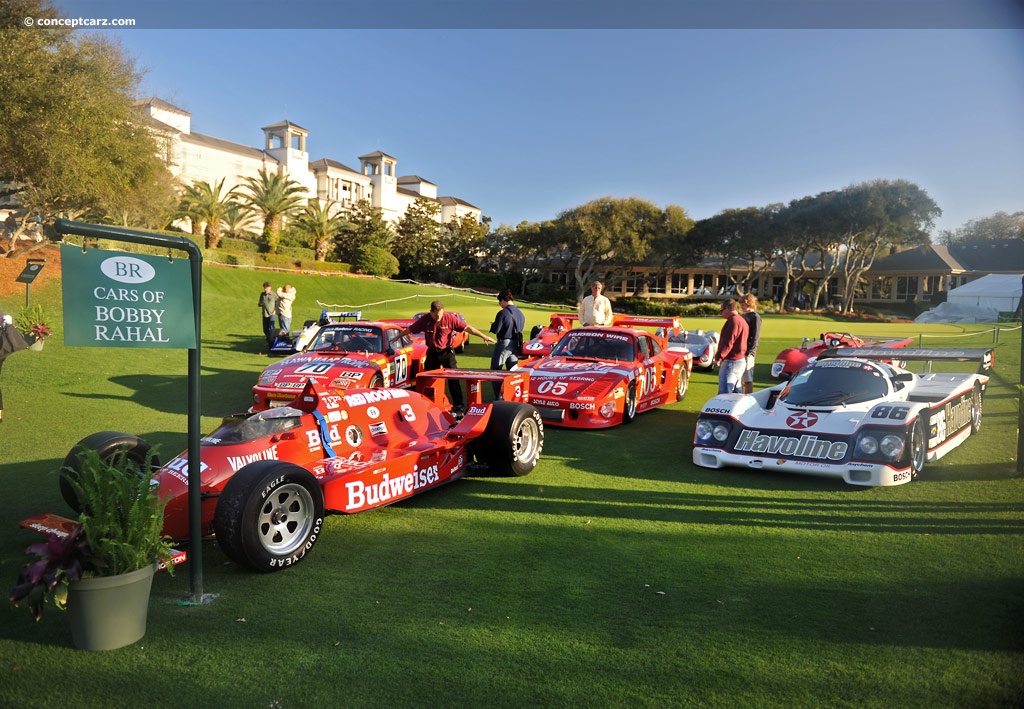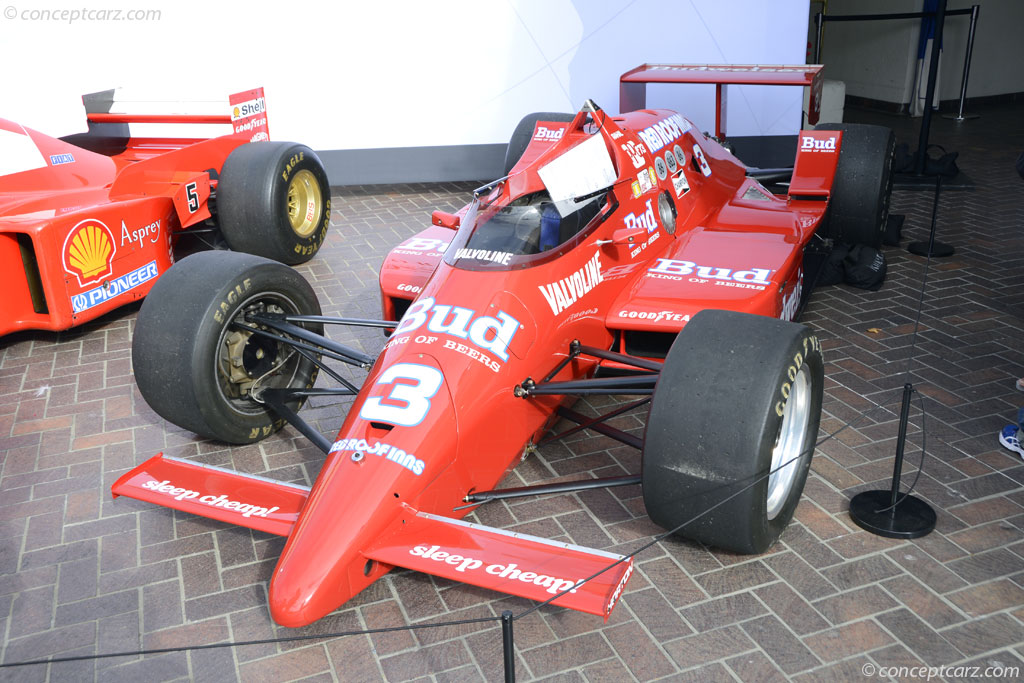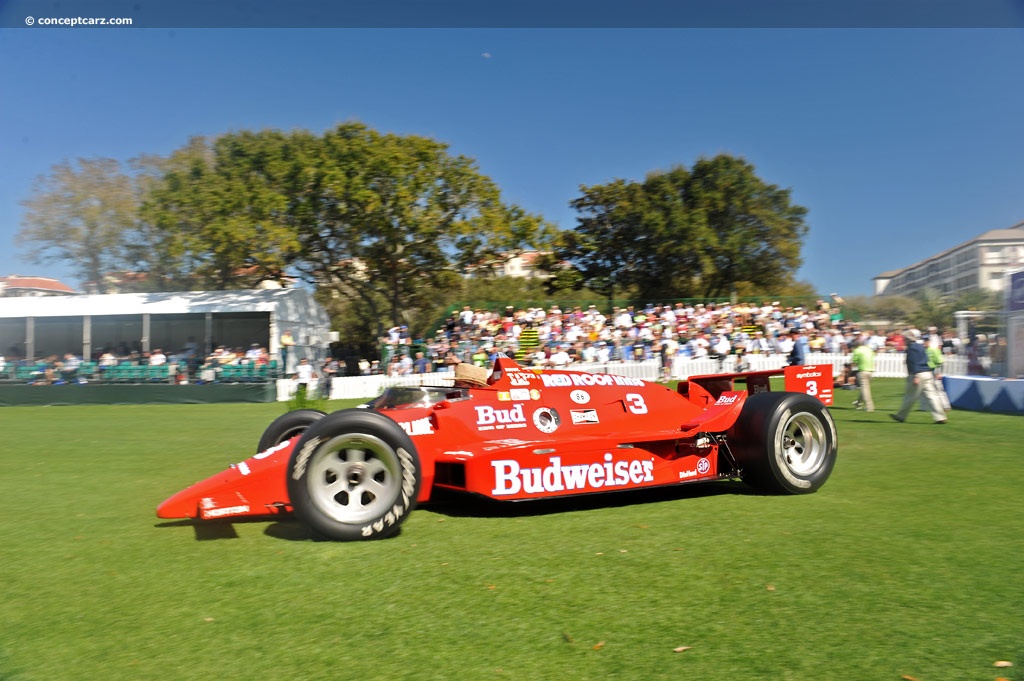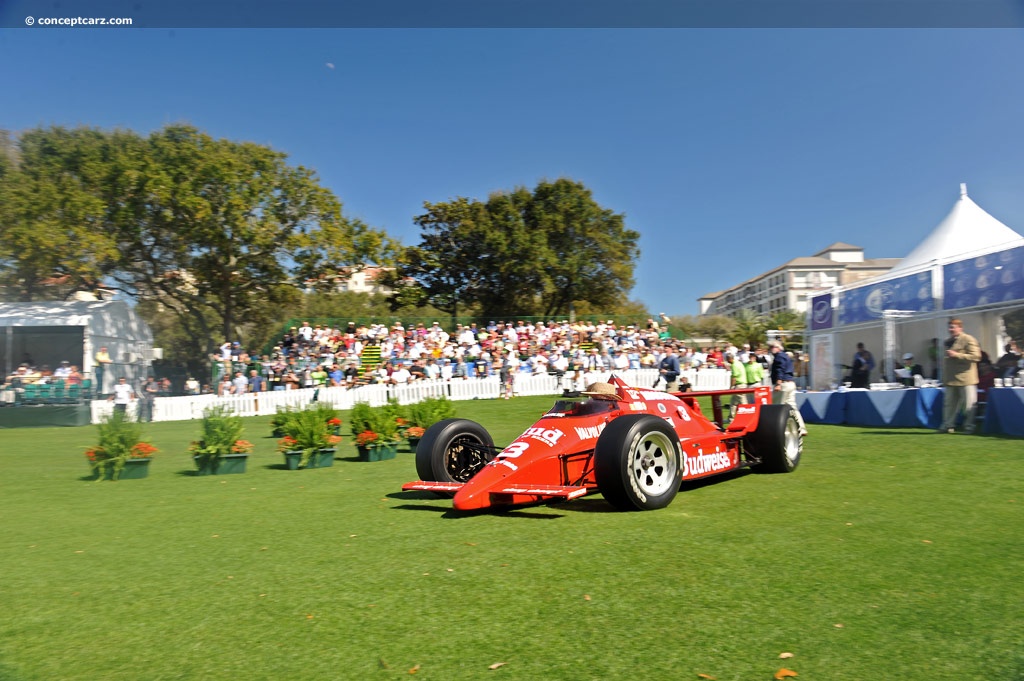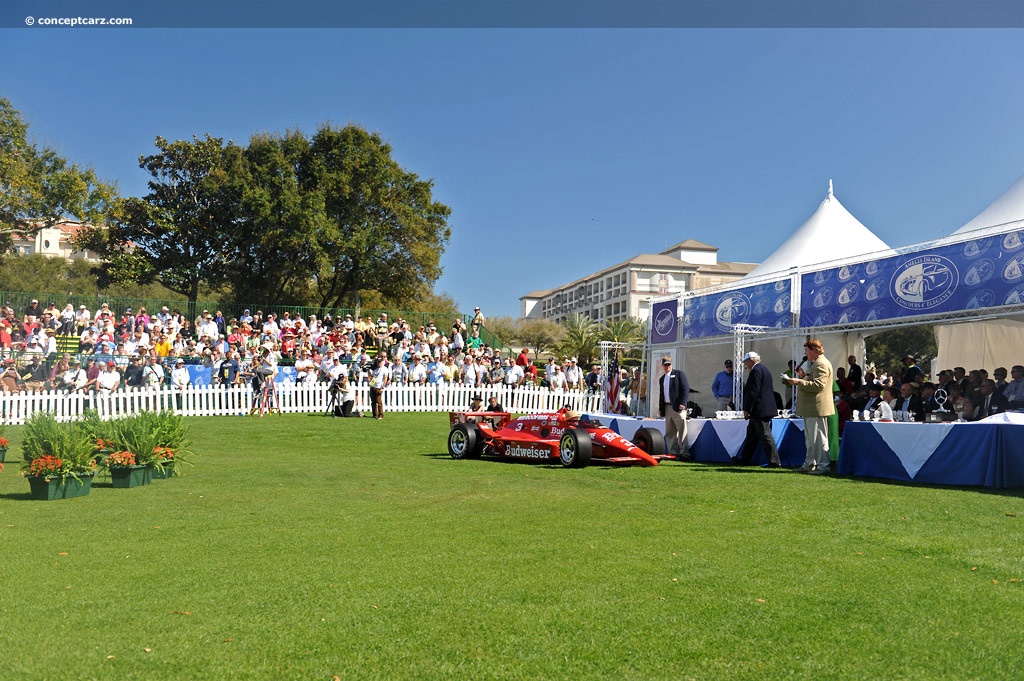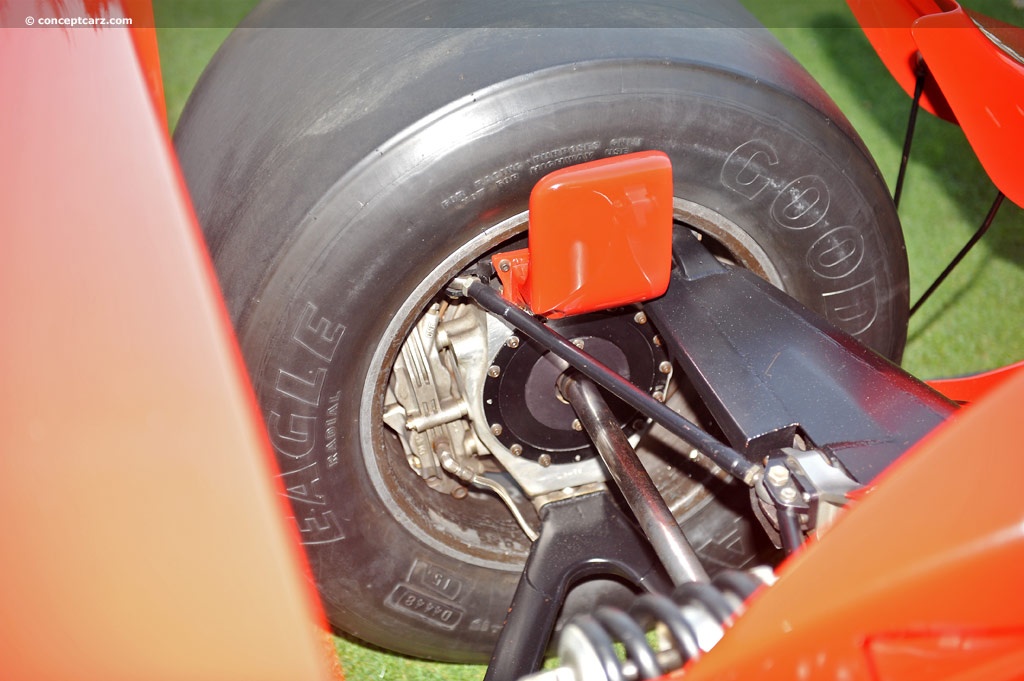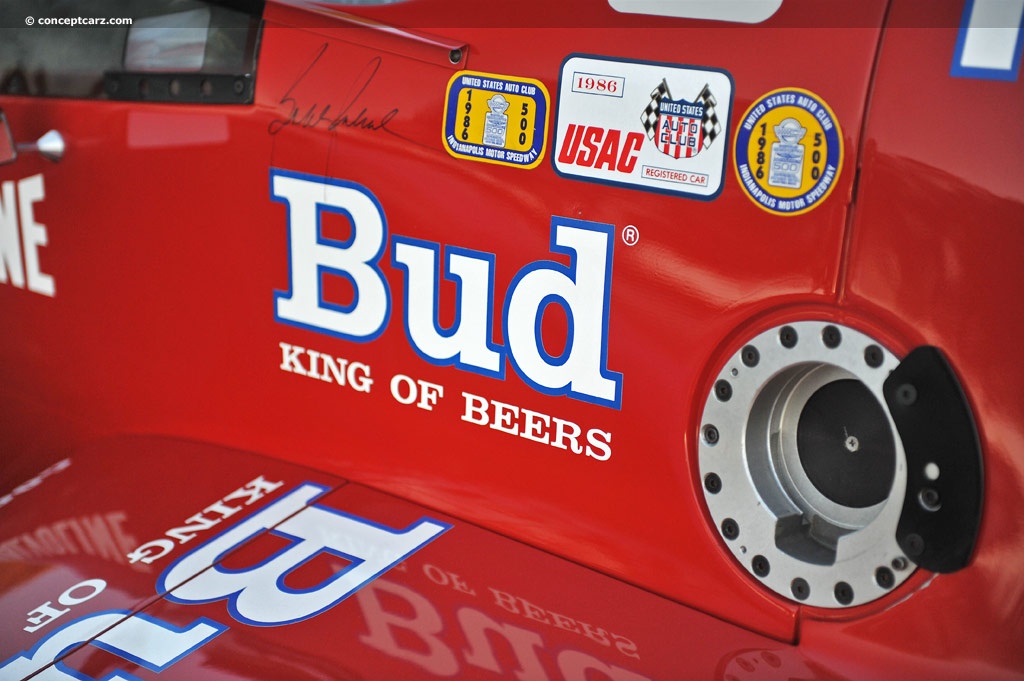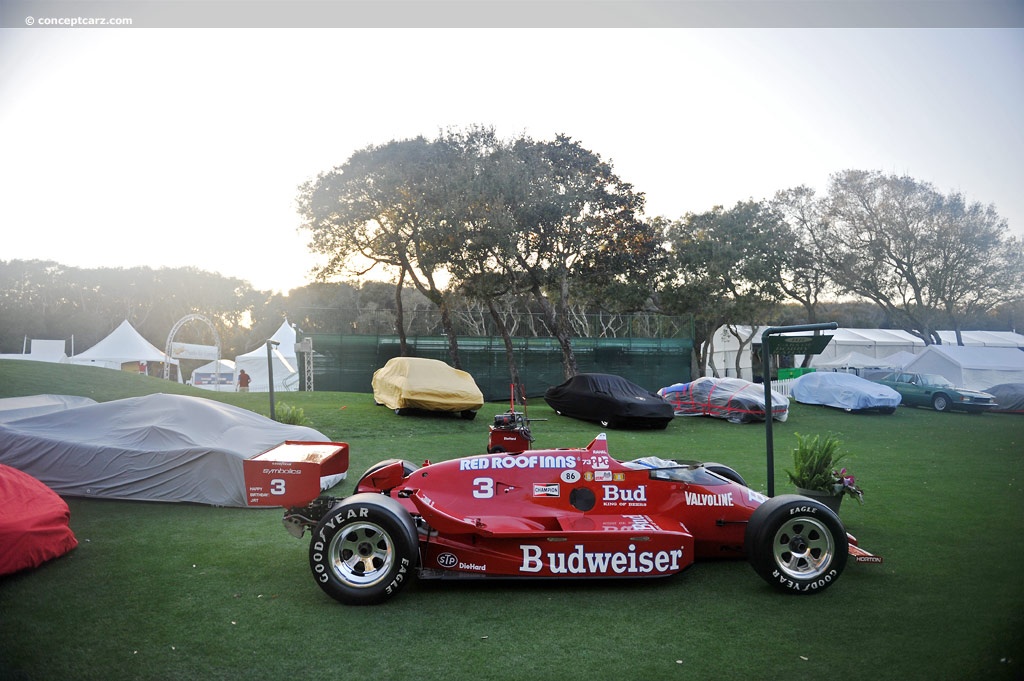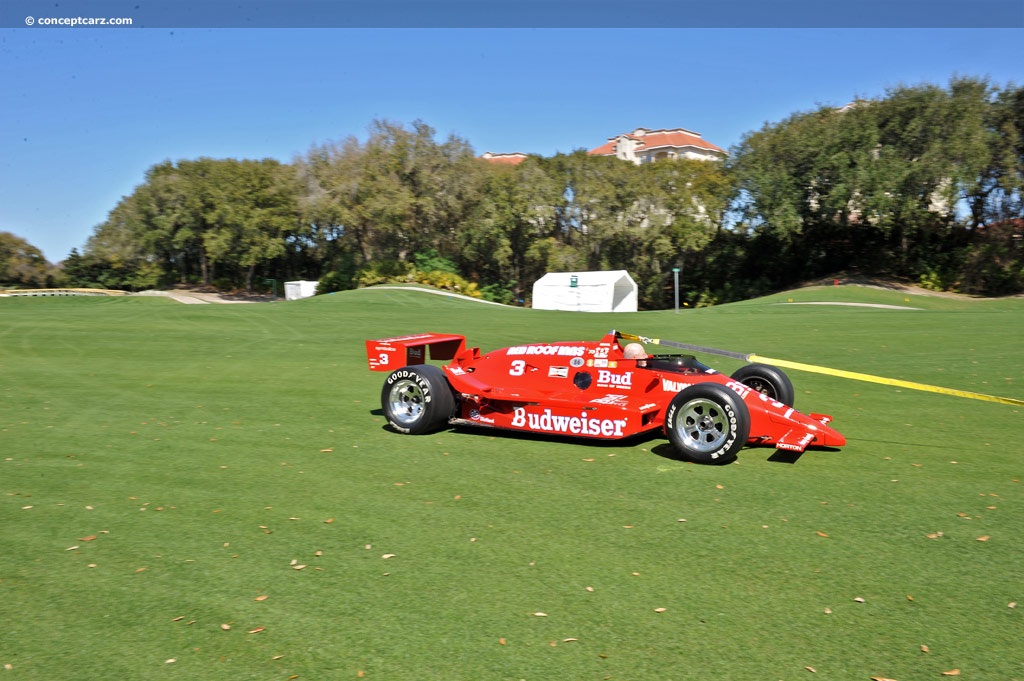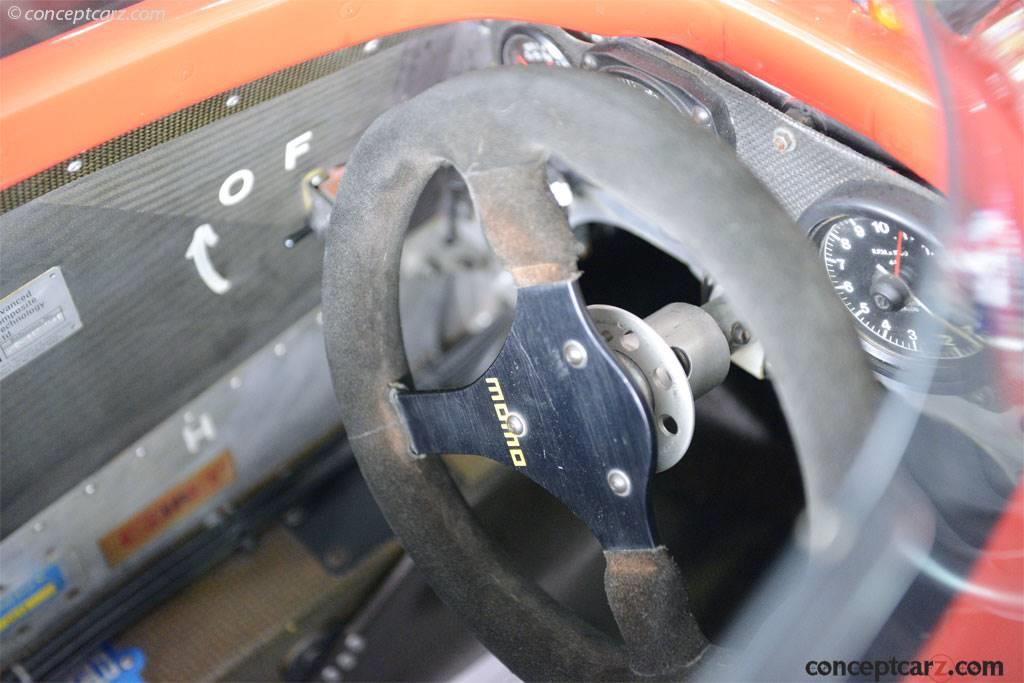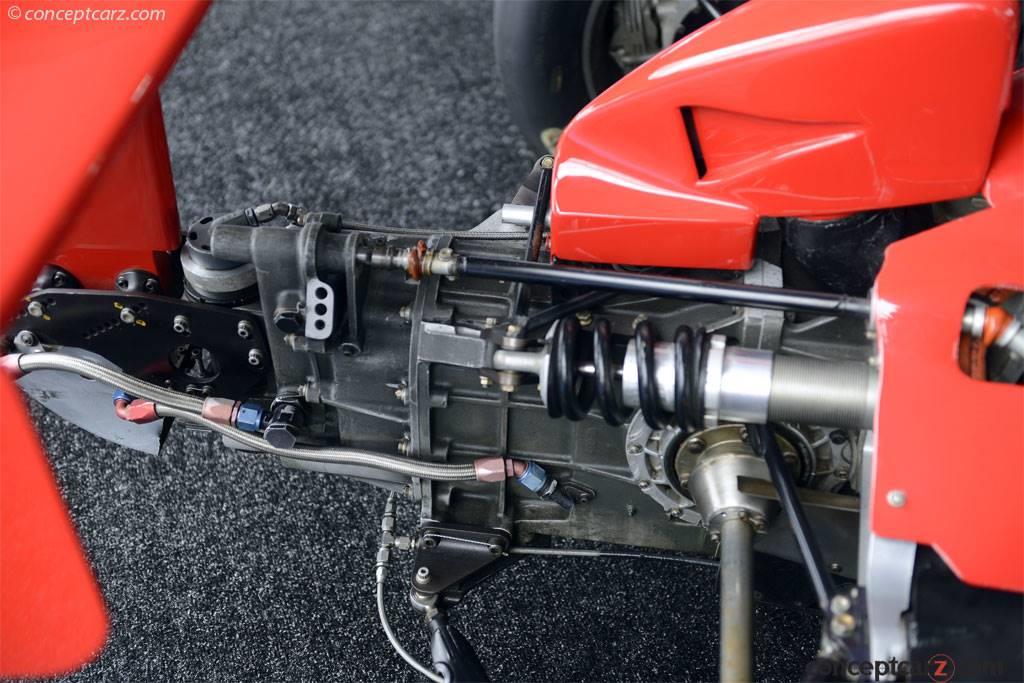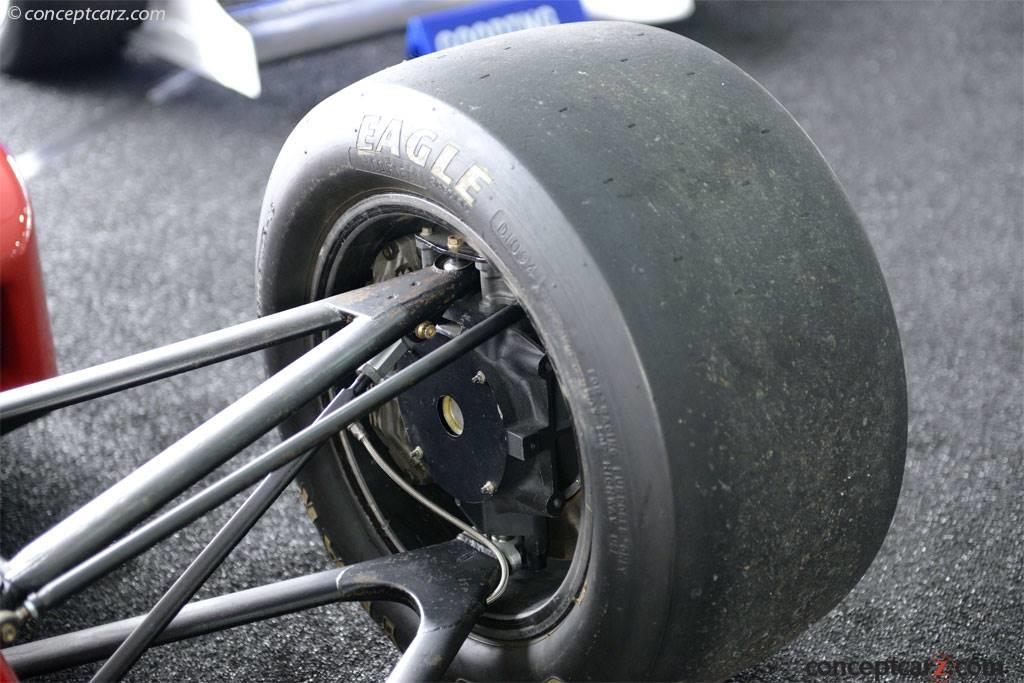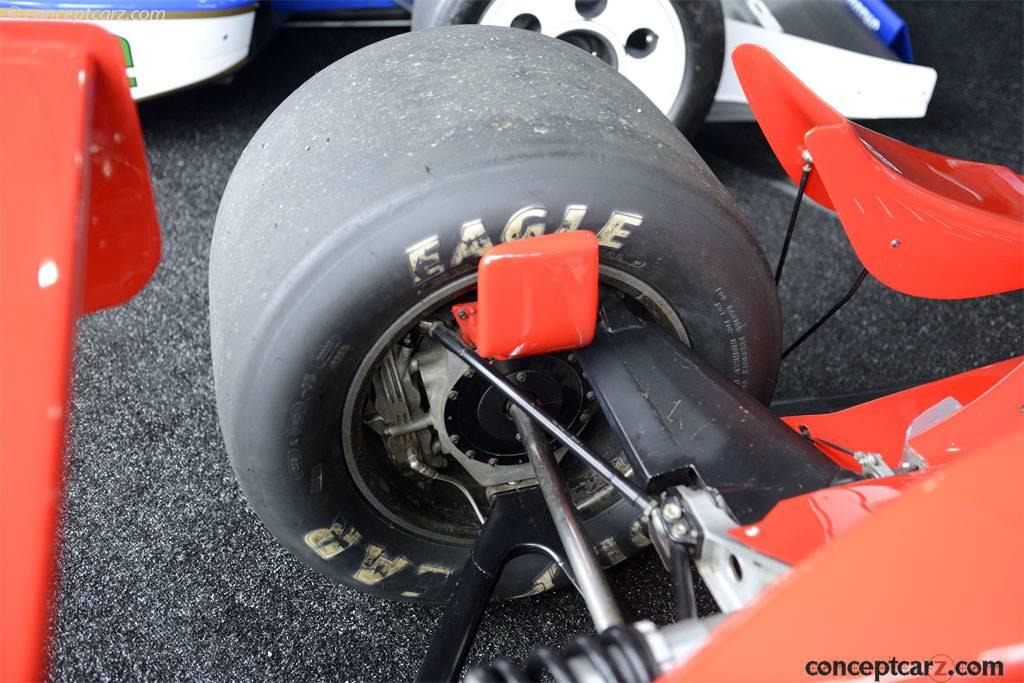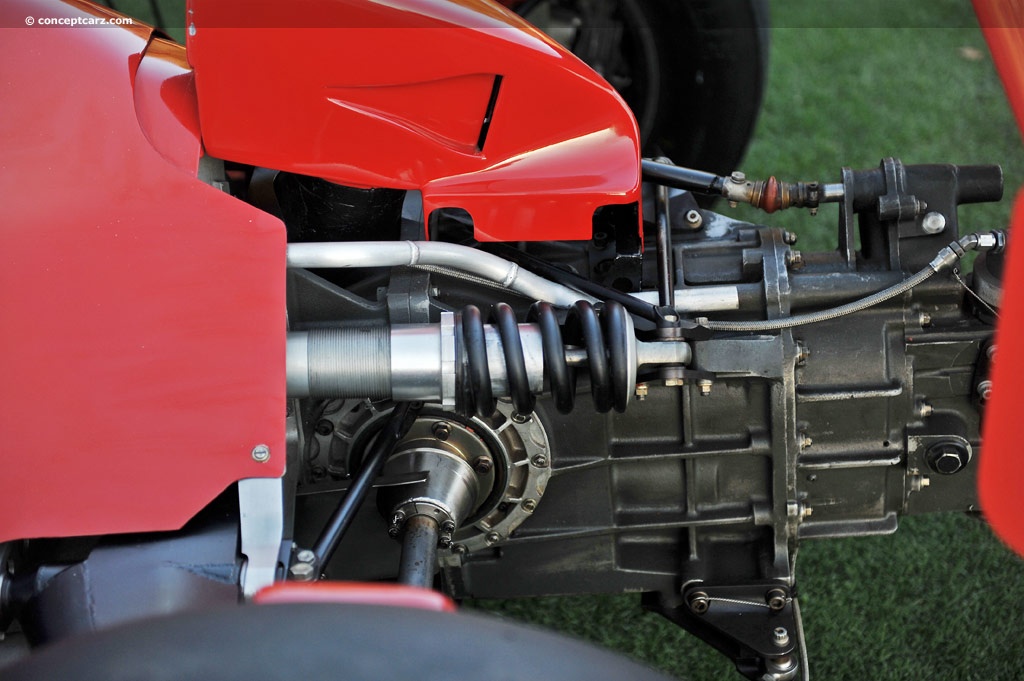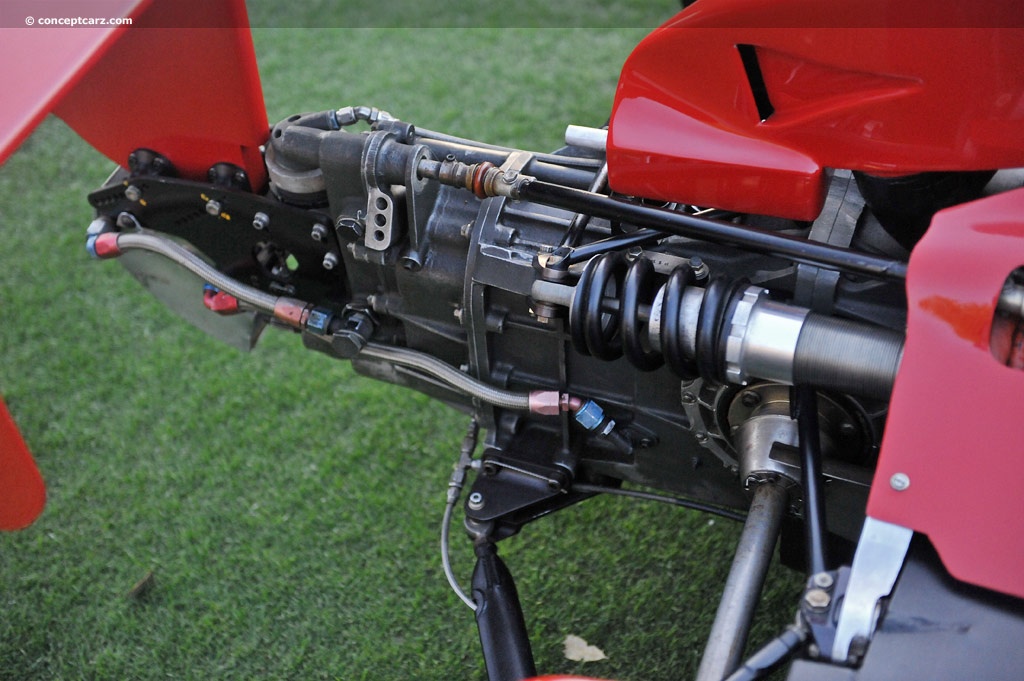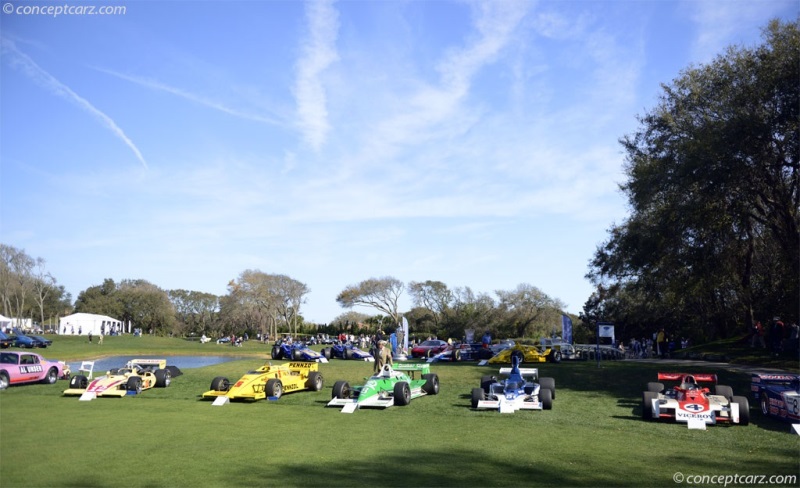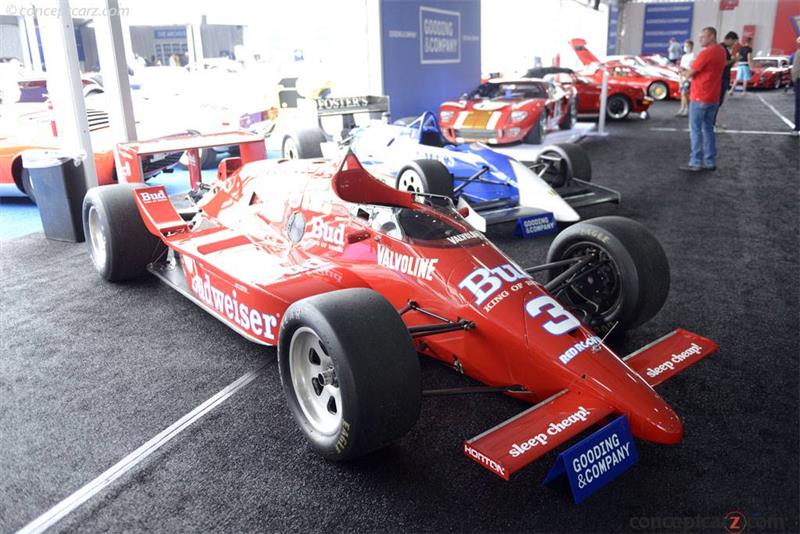Image credit: © conceptcarz.com (Reproduction Or reuse prohibited).
This is the 1986 Truesports/Budweiser March 86-C with chassis #13. After rain had washed out two previous days of racing, Bobby Rahal won the Indianapolis 500 on June 1, 1986, in this very chassis, #13, in one of the closest finishes in Indy 500 history. Bobby, driving for Truesports Racing, pulled past Kevin Cogan on the final restart with two laps remaining and won by 1.4 seconds. Bobby went on to win Toronto, Mid-Ohio, Sanair, Michigan, and Laguna Seca in 1986 and won the CART Indy Car Driver's Championship. He won it again for Truesports in 1987. At the end of the 1986 season, this chassis was returned to its exact Indy 500 livery with the winning Cosworth motor and was used for display by Budweiser in 1987. In 1988, the Truesports team was attempting to design and build its own American-made chassis and to help cover the cost, they sold this winning car to the current owner.
Each and every car to win the Indianapolis 500 has a story behind it. While the victory seems straightforward, there are often so many subplots that make for compelling viewing. The subplots surrounding Bobby Rahal's win in 1986 would be so overwhelming even Hollywood would have a hard time coming up with something better.
Today, Adrian Newey's genius as a car designer is without question. However, in the mid-1980s, he was still a name that people had heard of, but were still unsure of whom he was exactly. That would begin to change in 1984. In 1985, his reputation was secured. Then, in 1986, a red March would come streaking across the yard of bricks at Indy. Everything would change practically overnight, but not just for Newey.
It would really all start with an overly-ambitious car design firm from England known by the acronym M.A.R.C.H. A group of four men would start the company with the intention of fielding cars in most of the major categories of motor racing at the time. Of course, Formula One was the biggest aim. Unfortunately, success would be sparse. This would lead to the firm looking elsewhere to earn its fame. Indycars seemed like another logical option.
March would come and go in Formula One. When it returned in 1981, it did so with an example of a Williams FW07. March would make some changes and improvements to the car and would soon realize they had a good foundation for an Indycar. Therefore, the March 81C would be fashioned for the mix of ovals and road courses used within the American series and would quickly become a popular choice with teams.
Success for March came swiftly as their cars would go on to win the 1983, 1984, and 1985 Indianapolis 500s. The success and diversity of March made the company an attractive place to work for aspiring young engineers. One of those would be a Stratford-upon-Avon man by the name of Adrian Newey.
Newey, who certainly had a penchant for trouble-making when he was younger, was a talented engineer. Earning First Class honors in Aeronautics and Astronautics from the University of Southampton, he would soon find his talents for aeronautical engineering being used in car design working under Harvey Postlethwaite in the Fittipaldi Formula One team. Then, in 1981, he moved to March lending a hand on many of the projects undertaken by the company.
Newey's first major project would be designing a prototype car for the IMSA GTP series based in the United States. Creating the famed 'lobster-claw'. This adaptable design was practically unbeatable winning the IMSA GTP title two years in a row.
The success in IMSA racing led Robin Herd at March to bring Newey into the Indycar program to work with customer teams. Newey would come onboard and would soon meet and form a close friendship with Bobby Rahal, who was driving for Truesports at the time.
Jim Trueman and Bobby Rahal had a long-standing relationship since the 1970s, especially from the moment Trueman lent Rahal $500 to enter a race at Watkins Glen. Jim believed in the talented Rahal and would end up hiring him on as his principal driver when he made the jump to Indycars in 1982. Newey's piece in this puzzle came along just a couple of years later. Rahal and Newey would become good friends and would work closely together developing the March Indycar. The result would be a 3rd place in the 1984 Indycar Championship.
Newey's work didn't just aid the Truesports team. His 85C chassis would be used by Al Unser, who would take it to the title that year. The 85C would also be driven by Danny Sullivan, the winner of that year's Indy 500. Suddenly, Newey was a man in demand. He genius solidified. March needed to take advantage of this. Therefore, Newey would be pulled from the Indycar project and would do work for the company trying to attract even greater investments and interest. He would also be hired by Kraco to serve as engineer to Michael Andretti. His path in motorsports was now on the move and it would result in a long-standing period in Formula One where he would become perhaps the greatest designer in Formula One history, designing such cars as the Williams FW14B and FW15, championship-winning cars with McLaren and, of course, a string of multiple championship winners at Red Bull.
Back to 1986. While Newey's career was just taking-off, Trueman's was coming to an abrupt end. Only days before what was to be the start of the 70th Indianapolis 500, Trueman would be diagnosed with cancer and given very little time left in which to live. This would be difficult news for Rahal who was close to Trueman and had had so many memorable moments driving for his friend. Add to this the fact the first two races of the season had not been particularly good ones, and the reality was things really could not have been much worse.
It would be hard to put aside the news and the poor start to the season, but really, there wasn't a hotter driver in Indycar than Bobby Rahal. He had finished the 85 season with three-straight wins. Rahal's close relationship with Newey led to a number of changes over the course of the season and Bobby would profit greatly.
Newey's departure from the program meant the Truesports team needed to find another capable of preparing the 86C. Steve Horne and Grant Newbury would be more than capable of updating the car over the course of the year and Rahal's starting position for the race would be evidence of this fact. Starting from the 4th place on the grid, Rahal would be up at the front and in a great position for the 200-lap race.
Rahal would run up at the front nearly the whole of the race. In fact, he and pole-sitter Rick Mears would be embroiled in a great battle for the lead. However, with about 20 laps remaining, Kevin Cogan would add his name to the fight. He would make a couple of incredible passes through traffic to take over the lead. Pulling out a lead, it seemed the victory would go to him.
Then there was a late caution that bunched the field back up again. This was Rahal's last opportunity for a victory at the Brickyard. He wouldn't miss it. Picking up the throttle quicker than any of the others, Rahal would sweep by Cogan into the first turn and would be in the lead. Still, there was no time for the Truesports driver to relax as Cogan would remain right there.
Among hundreds of thousands of fans cheering and shouting over top of the noise of the engines, and among all of the drama outside of the track, Rahal turned for home and powered his way toward the yard of bricks for the final time. Flashing across the line to take the victory, the scene would be absolutely electric. Yet, Trueman would see none of it. With his head turned away from the track from the moment of the beginning of the last lap, Trueman would not see the gift given him by his friend out on the track, but it didn't matter. He knew. Cancer may have taken his life just eleven days later, but Trueman would overcome everything on that 31st of May. As Rahal would say, as the wreath was being placed around his neck, 'This one's for Jim Trueman…If there is one thing I can give him it's this.'
All of the emotion of the moment, the milk spilled from victory, even pieces from the wreath would all be caught by chassis 86C-13, the March chassis that had beaten all the others to take its place in Indianapolis 500 fame. However, even the fame of the victory would nearly too little to save it.
This same chassis would not only go on to win the Indy 500, but it would also go on to win the Indycar Championship for 1986. However, room needed to be made for the '87 model cars, even famous race winners could not be spared.
It just wasn't right and numerous voices would speak up. The loudest voice would be the team's biggest sponsor—Budweiser. Keen to take advantage of the promotional value of the car, Budweiser would take the car on tour throughout 1987. But though it had gone on to win the championship, 86C-13 needed to be presented in its Indy 500 glory. Therefore, work would be done and the car would be returned to its resplendent Indy 500 glory, and then, would set off across the country. Nearly every detail of the car would be returned to its original look at Indy. This included its original rear wing, engine and even Jim Trueman's sticker celebrating his birthday.
Such a famous Indycar would not be forgotten. Soon after the tour for Budweiser the car would be purchased by its current owner and would become part of an impressive collection. The car would not sit idly in some collection, however. It would make a number of appearances for nearly 25 years. It could be found at the Indianapolis Motor Speedway and would even cross the Atlantic to make an appearance in the Goodwood Festival of Speed in 2011. This would be a special occasion as not only Bobby Rahal, but Adrian Newey, would all take a turn going up the hill.
Associated with some of the most famous names in the world of motorsports, this nearly discarded Indy winner is a central figure in one of the most intriguing stories of Indycar history and a moving tribute to Trueman, Rahal and NeweyBy Jeremy McMullen
Today, Adrian Newey's genius as a car designer is without question. However, in the mid-1980s, he was still a name that people had heard of, but were still unsure of whom he was exactly. That would begin to change in 1984. In 1985, his reputation was secured. Then, in 1986, a red March would come streaking across the yard of bricks at Indy. Everything would change practically overnight, but not just for Newey.
It would really all start with an overly-ambitious car design firm from England known by the acronym M.A.R.C.H. A group of four men would start the company with the intention of fielding cars in most of the major categories of motor racing at the time. Of course, Formula One was the biggest aim. Unfortunately, success would be sparse. This would lead to the firm looking elsewhere to earn its fame. Indycars seemed like another logical option.
March would come and go in Formula One. When it returned in 1981, it did so with an example of a Williams FW07. March would make some changes and improvements to the car and would soon realize they had a good foundation for an Indycar. Therefore, the March 81C would be fashioned for the mix of ovals and road courses used within the American series and would quickly become a popular choice with teams.
Success for March came swiftly as their cars would go on to win the 1983, 1984, and 1985 Indianapolis 500s. The success and diversity of March made the company an attractive place to work for aspiring young engineers. One of those would be a Stratford-upon-Avon man by the name of Adrian Newey.
Newey, who certainly had a penchant for trouble-making when he was younger, was a talented engineer. Earning First Class honors in Aeronautics and Astronautics from the University of Southampton, he would soon find his talents for aeronautical engineering being used in car design working under Harvey Postlethwaite in the Fittipaldi Formula One team. Then, in 1981, he moved to March lending a hand on many of the projects undertaken by the company.
Newey's first major project would be designing a prototype car for the IMSA GTP series based in the United States. Creating the famed 'lobster-claw'. This adaptable design was practically unbeatable winning the IMSA GTP title two years in a row.
The success in IMSA racing led Robin Herd at March to bring Newey into the Indycar program to work with customer teams. Newey would come onboard and would soon meet and form a close friendship with Bobby Rahal, who was driving for Truesports at the time.
Jim Trueman and Bobby Rahal had a long-standing relationship since the 1970s, especially from the moment Trueman lent Rahal $500 to enter a race at Watkins Glen. Jim believed in the talented Rahal and would end up hiring him on as his principal driver when he made the jump to Indycars in 1982. Newey's piece in this puzzle came along just a couple of years later. Rahal and Newey would become good friends and would work closely together developing the March Indycar. The result would be a 3rd place in the 1984 Indycar Championship.
Newey's work didn't just aid the Truesports team. His 85C chassis would be used by Al Unser, who would take it to the title that year. The 85C would also be driven by Danny Sullivan, the winner of that year's Indy 500. Suddenly, Newey was a man in demand. He genius solidified. March needed to take advantage of this. Therefore, Newey would be pulled from the Indycar project and would do work for the company trying to attract even greater investments and interest. He would also be hired by Kraco to serve as engineer to Michael Andretti. His path in motorsports was now on the move and it would result in a long-standing period in Formula One where he would become perhaps the greatest designer in Formula One history, designing such cars as the Williams FW14B and FW15, championship-winning cars with McLaren and, of course, a string of multiple championship winners at Red Bull.
Back to 1986. While Newey's career was just taking-off, Trueman's was coming to an abrupt end. Only days before what was to be the start of the 70th Indianapolis 500, Trueman would be diagnosed with cancer and given very little time left in which to live. This would be difficult news for Rahal who was close to Trueman and had had so many memorable moments driving for his friend. Add to this the fact the first two races of the season had not been particularly good ones, and the reality was things really could not have been much worse.
It would be hard to put aside the news and the poor start to the season, but really, there wasn't a hotter driver in Indycar than Bobby Rahal. He had finished the 85 season with three-straight wins. Rahal's close relationship with Newey led to a number of changes over the course of the season and Bobby would profit greatly.
Newey's departure from the program meant the Truesports team needed to find another capable of preparing the 86C. Steve Horne and Grant Newbury would be more than capable of updating the car over the course of the year and Rahal's starting position for the race would be evidence of this fact. Starting from the 4th place on the grid, Rahal would be up at the front and in a great position for the 200-lap race.
Rahal would run up at the front nearly the whole of the race. In fact, he and pole-sitter Rick Mears would be embroiled in a great battle for the lead. However, with about 20 laps remaining, Kevin Cogan would add his name to the fight. He would make a couple of incredible passes through traffic to take over the lead. Pulling out a lead, it seemed the victory would go to him.
Then there was a late caution that bunched the field back up again. This was Rahal's last opportunity for a victory at the Brickyard. He wouldn't miss it. Picking up the throttle quicker than any of the others, Rahal would sweep by Cogan into the first turn and would be in the lead. Still, there was no time for the Truesports driver to relax as Cogan would remain right there.
Among hundreds of thousands of fans cheering and shouting over top of the noise of the engines, and among all of the drama outside of the track, Rahal turned for home and powered his way toward the yard of bricks for the final time. Flashing across the line to take the victory, the scene would be absolutely electric. Yet, Trueman would see none of it. With his head turned away from the track from the moment of the beginning of the last lap, Trueman would not see the gift given him by his friend out on the track, but it didn't matter. He knew. Cancer may have taken his life just eleven days later, but Trueman would overcome everything on that 31st of May. As Rahal would say, as the wreath was being placed around his neck, 'This one's for Jim Trueman…If there is one thing I can give him it's this.'
All of the emotion of the moment, the milk spilled from victory, even pieces from the wreath would all be caught by chassis 86C-13, the March chassis that had beaten all the others to take its place in Indianapolis 500 fame. However, even the fame of the victory would nearly too little to save it.
This same chassis would not only go on to win the Indy 500, but it would also go on to win the Indycar Championship for 1986. However, room needed to be made for the '87 model cars, even famous race winners could not be spared.
It just wasn't right and numerous voices would speak up. The loudest voice would be the team's biggest sponsor—Budweiser. Keen to take advantage of the promotional value of the car, Budweiser would take the car on tour throughout 1987. But though it had gone on to win the championship, 86C-13 needed to be presented in its Indy 500 glory. Therefore, work would be done and the car would be returned to its resplendent Indy 500 glory, and then, would set off across the country. Nearly every detail of the car would be returned to its original look at Indy. This included its original rear wing, engine and even Jim Trueman's sticker celebrating his birthday.
Such a famous Indycar would not be forgotten. Soon after the tour for Budweiser the car would be purchased by its current owner and would become part of an impressive collection. The car would not sit idly in some collection, however. It would make a number of appearances for nearly 25 years. It could be found at the Indianapolis Motor Speedway and would even cross the Atlantic to make an appearance in the Goodwood Festival of Speed in 2011. This would be a special occasion as not only Bobby Rahal, but Adrian Newey, would all take a turn going up the hill.
Associated with some of the most famous names in the world of motorsports, this nearly discarded Indy winner is a central figure in one of the most intriguing stories of Indycar history and a moving tribute to Trueman, Rahal and NeweyBy Jeremy McMullen
2021 Gooding & Company : Pebble Beach Concours Auction
Pre-Auction Estimates :
USD $1,500,000-USD $2,000,000
Sale Price :
USD $1,435,000
2014 RM Auctions at Monterey
Pre-Auction Estimates :
USD $1,750,000-USD $2,500,000
High Bid (Lot was not sold)
USD $1,550,000
Recent Sales of the March 86C
(Data based on Model Year 1986 sales)
| 1986 March 86C Chassis#: 86C-13 Sold for USD$1,435,000 2021 Gooding & Company : Pebble Beach Concours Auction |   |
March 86Cs That Failed To Sell At Auction
1986 March 86C's that have appeared at auction but did not sell.
| Vehicle | Chassis | Event | High Bid | Est. Low | Est. High |
|---|---|---|---|---|---|
| 1986 March 86C Indianapolis Racecar | 2015 Auctions America California | $20,000 | |||
| 1986 March 86C Indianapolis | 86C-13 | 2014 RM Auctions at Monterey | $1,550,000 | $1,750,000 | $2,500,000 |
Vehicles With Comparable Market Values
Similar sales to the $1,435,000 range.
| 1938 Mercedes-Benz 540 K Norrmalm Cabriolet Chassis#:169389 Sold for $1,435,000 2024 Broad Arrow Auctions : Amelia |   |
| 1930 Duesenberg Model J Hibbard & Darrin Transformable Cabriolet Chassis#:2329 Sold for $1,435,000 2023 Broad Arrow : Monterey Jet Center |   |
| 1969 Dodge Hemi Daytona Sold for $1,430,000 2023 Mecum : Kissimmee | |
| 1966 Shelby 427 Cobra Roadster Sold for $1,430,000 2023 Mecum : Kissimmee | |
| 1969 Dodge Hemi Daytona NASCAR Sold for $1,430,000 2023 Mecum : Kissimmee | |
| 1988 PORSCHE 962C Chassis#:962-139 Sold for $1,435,000 2022 Gooding & Company : Pebble Beach |   |
| 1931 Stutz DV-32 Convertible Victoria Coachwork by LeBaron Chassis#:DV-PC-1224 Sold for $1,435,000 2022 Bonhams : The Quail Auction |   |
| 1939 Mercedes-Benz 540 K Cabriolet A by Sindelfingen Chassis#:408388 Sold for $1,435,000 2022 RM Sothebys : Monterey |   |
| 2018 FORD GT 67 HERITAGE EDITION Chassis#:2FAGP9CW9JH100051 Sold for $1,430,000 2022 Barrett-Jackson : Palm Beach | |
| 1935 Delahaye 135M Competition Drophead Coupe Chassis#:135M46060 Sold for $1,435,000 2022 Worldwide Auctioneers : Scottsdale Arizona |   |
| 2017 FORD GT 66 HERITAGE EDITION Chassis#:2FAGP9CW6HH200084 Sold for $1,430,000 2022 Barrett-Jackson : Scottsdale, Arizona | |
| 1967 Shelby 427 Cobra Roadster Sold for $1,430,000 2022 Mecum : Kissimmee | |
| 1994 Porsche 911 Turbo Sold for $1,430,000 2022 Mecum : Kissimmee | |
| 1936 White Model 706 Glacier National Park Tour Bus Sold for $1,430,000 2022 Mecum : Kissimmee | |
| 1934 Packard Twelve Individual Custom Convertible Sedan Chassis#:902444 Sold for $1,435,000 2021 Worldwide Auctioneers : The 14th Annual Auburn Auction |   |
| 1986 March 86C Chassis#:86C-13 Sold for $1,435,000 2021 Gooding & Company : Pebble Beach Concours Auction |   |
| 1953 Bentley R-Type Continental Fastback Sports Saloon by H.J. Mulliner Chassis#:BC1LB Sold for $1,435,000 2021 RM Sothebys : Monterey |   |
| 1964 FERRARI 250 GT LUSSO Chassis#:5931 GT Sold for $1,430,000 2020 Gooding : Geared Online | |
| 1965 Ferrari 275 GTS Chassis#:07427 Sold for $1,430,000 2020 Mecum : Indy |   |
| 1969 Lamborghini Miura P400 S Chassis#:4109 Sold for $1,435,000 2020 Gooding & Company : Amelia Island |   |
